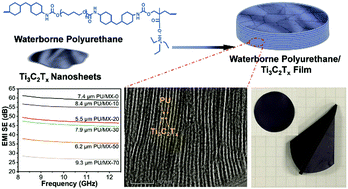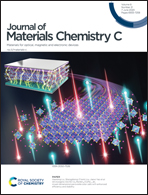Bioinspired ultra-thin polyurethane/MXene nacre-like nanocomposite films with synergistic mechanical properties for electromagnetic interference shielding†
Abstract
As electronic devices are rapidly developing and growing in huge numbers by the hour, there is an urgent demand to develop next generation electromagnetic interference (EMI) shielding materials that need to be flexible, ultra-thin, light in weight, mechanically strong and highly efficient in blocking the electromagnetic waves. We address this problem by fabricating polyurethane/Ti3C2Tx MXene nanocomposite films with a nacre-like “brick and mortar” highly ordered nanostructure. The nacre mimetic polyurethane/MXene nanocomposite films combine impressive flexibility, very good mechanical properties (tensile strength ∼100 MPa, fracture toughness ∼3.0 MJ m−3), superior electric conductivity (∼2897.4 S cm−1), outstanding EMI shielding properties (thickness specific shielding effectiveness: 33771.92 dB cm2 g−1), and ultra-small thickness (<10 μm), which can be attributed to the bioinspired material design and the careful choice of polyurethane as a polymer matrix. We envisage further advancing of the property profiles of the EMI shielding nanocomposites by optimizing the soft polymer interactions and their wide applications in different fields.



 Please wait while we load your content...
Please wait while we load your content...